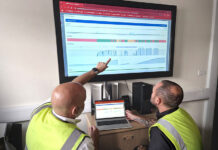
Neil Giles, Marketing Communications Manager at Mettler-Toledo Product Inspection, outlines what food manufacturers should know about the new BRC V7 Standards.

GLOBALLY, food safety is a major concern for consumers and retailers alike. Rare, but high-profile food safety incidents due to foreign body contamination in major Western and Asian markets have served to keep the issue at the forefront of the public’s consciousness.
To ensure consumer safety, and protect manufacturer and retailer brands from costly product recalls, large European stores have required their suppliers to comply with food safety standards for many years now. The principal food safety standards across the globe are recognised by the Global Food Safety Initiative (GFSI) and based on the Hazard Analysis and Critical Control Point (HACCP) set of principles. One main set of guidelines is the British Retail Consortium (BRC) Global Standards. This certification program is used by over 22,000 suppliers in 123 countries supplying food products predominantly to English and Scandinavian retailers.
In January 2012, the BRC released Global Standards Version 6 with guidelines created to enhance consumer safety, including requirements for the type and location of product inspection equipment on food production lines, maintenance procedures and documentation to demonstrate due diligence. In January 2015, the BRC released the seventh version, a revision on of its Global Standard on food safety. In effect from July 2015, Version 7 focuses on the increased implementation of good manufacturing practices in areas where product recalls and withdrawals often arise, such as packaging and labelling management.
Expanding the Scope of Safety
When putting controls into place that protect against contaminants, knowing where to locate product inspection technology is key. V7 of the BRC Standards has been expanded to include packaging, in addition to the raw materials, themselves. Clause 3.5.2.1 requires manufacturers to implement a documented procedure for the acceptance of raw materials, now including packaging, and various components, such as product sampling, testing, and visual inspection.
In cases where packaging is outsourced to a third party, the new V7 requires a documented site audit that includes product safety, traceability, HACCP review, and good manufacturing practices by ‘an experienced and demonstrably competent product safety auditor’.
Ensuring Proper Labelling & Product Authenticity
The potential health risks associated with allergens is also addressed by the new standard. V7: Clause 5.2 now specifies that product labelling must comply with legal requirements and the manufacturer has to identify and list any known allergens-containing materials handled on site, including raw materials, processing aids, intermediate and finished products, and any new product development ingredients. In addition, a list must be made available that includes products not containing allergens that require contamination protection (V7: Clause 5.3.2).
Per V7 Clause 6.2, formalised labelling and package control processes must be implemented to ensure that only packaging for immediate use is available at packaging machines.
When coding or inking packaging, there must also be checks in place that make sure only correctly printed material is provided. Where on line vision equipment is used to check product labels and printing, procedures must be applied to ensure that the system is correctly set up and able to alert or reject product when packaging information is incorrect (V7: Clause 6.2.5).
Changes in V7 have also been made to protect against adulterated raw materials in the supply chain that might include contaminants not listed on packaging. For example, in the event of potential adulteration of raw materials, the company must have a process in place to alert trade associations, government agencies and private resource centres (V7: Clause 5.4.1).
A documented vulnerability assessment must now be performed on all raw materials to determine the potential risk of adulteration, including historical evidence, ease of access, and sophistication of routine testing (V7: Clause 5.4.2). Where raw materials are determined to have a potential risk factor, appropriate assurance and/or testing processes must be in place to mitigate the risk (V7: Clause 5.4.3).
Reporting Contamination Incidents
For comprehensive compliance with BRC Global Standards, as well as protection for both brand and consumer, food manufacturers must implement procedures to rectify any problems identified after every contamination incident or test failure.
In both versions, Clause 4.10.3.5 requires the isolation of all products manufactured since the last successful test for re-inspection. In addition, there should be adequate reporting mechanisms in place to alert operators to any product inspection problems.
In the event of a product recall, brand owners can demonstrate that they have undertaken all due diligence in minimising contamination risk to consumers. Though unstated in the updated standards, manufacturers should keep records for as long as possible to protect themselves against contamination claims that may occur years after the product has left the factory floor.
Be Aware
Governments, retailers and consumers are increasingly aware of the issue of food safety, and updates to regulations, such as BRC Global Standards Version 7, are constantly going into effect. Food manufacturers must understand any new guidelines and take active steps to ensure that their product inspection systems are compliant in every way. This is vital to safeguarding consumer wellbeing, protecting their brand, and growing their business in lucrative markets.













